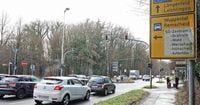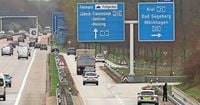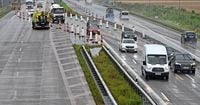Traffic conditions across various regions in Germany are currently experiencing significant disruptions due to construction and accidents, as reported by local traffic monitoring services. From Lübeck to Gifhorn, drivers are facing delays and congested routes, prompting the need for real-time updates on traffic situations.
In Lübeck, the traffic situation is particularly challenging. The latest reports indicate that major motorways such as the A1, A20, and A226, along with federal roads B75, B207, and B104, are heavily impacted. According to the ADAC, the A1 and A7 are among the most congested routes in Schleswig-Holstein, especially during tourist peak times. The A1, which connects Hamburg to coastal towns, frequently suffers from traffic jams, making it a critical focus for commuters and travelers alike.
The data for Lübeck's traffic updates is sourced from TomTom, a leading navigation service that compiles information from millions of GPS devices. This data is refreshed every five minutes, ensuring that motorists receive the most current information available. As the report notes, "Please always consider other road users"—a reminder for all drivers to remain vigilant and courteous.
Moving west to Havelland, the traffic situation reveals similar challenges. Key routes including the A2, A10, and A14, as well as federal roads B5, B102, and B188, are experiencing notable delays. Cities like Falkensee, Nauen, and Rathenow are particularly affected, with reports indicating that traffic is moving noticeably slower than usual. Again, TomTom’s data collection methods provide a reliable picture of the current conditions, with automatic data from around 80 million mobile devices and several million road sensors contributing to the accuracy of the information.
As with Lübeck, motorists in Havelland are advised to exercise caution and patience on the roads. The same traffic update service emphasizes the importance of safety and consideration for fellow drivers.
In Remscheid, the traffic conditions are also under scrutiny. The region, which includes Wermelskirchen, Solingen, and Wuppertal, is grappling with congestion on major motorways A1 and A46, alongside several federal roads such as B51, B51n, B229, B237, B483, and state roads L74, L81, L101, and L418. The ADAC highlights that the A1 is particularly notorious for traffic jams, having recorded nearly 6,500 hours of delays between Cologne and Dortmund in 2023. Furthermore, the A46 is noted as the sixth most congested route in North Rhine-Westphalia (NRW), connecting Düsseldorf to Wuppertal.
TomTom's data collection in Remscheid mirrors that of other regions, offering updates every five minutes to keep drivers informed. The report underscores the necessity for drivers to remain considerate of others on the road.
In Solingen, the situation is similarly dire, with key routes including the A1, A3, and A46 facing severe congestion. The A3 has been identified as the number one traffic jam route in NRW, with over 10,000 hours of delays reported in 2023. Ongoing construction projects, particularly around the Solingen interchange, are exacerbating the traffic woes, making it essential for drivers to stay updated.
The roads in and around Solingen, such as B229 and B224, are crucial for local connectivity. The traffic update service, powered by TomTom, continues to provide crucial data for motorists, with updates occurring every five minutes.
Further north in Gifhorn, the traffic landscape is similarly challenging. Key highways A2 and A39, along with federal roads B188, B4, B214, B248, and K114, are experiencing delays. The traffic update service in Gifhorn, like in other regions, relies on TomTom's extensive data collection methods, ensuring that drivers are informed about current conditions every five minutes.
In all these regions, the overarching message remains the same: drivers should always be mindful of their surroundings and the safety of other road users. As traffic conditions fluctuate, the importance of real-time updates cannot be overstated, providing essential information for those navigating the often unpredictable roads of Germany.
As we continue to monitor the traffic situations across these regions, it becomes clear that the reliance on technology, such as GPS data from millions of devices, is vital for maintaining safety and efficiency on the roads. The collaboration between local traffic monitoring services and navigation technology highlights the importance of accurate and timely information for all road users.
In conclusion, the current traffic conditions across various regions in Germany are a reminder of the challenges faced by commuters and travelers alike. With ongoing construction and the potential for accidents, staying informed is crucial. The commitment to providing updated traffic information every five minutes reflects the dedication to ensuring road safety and efficiency.




